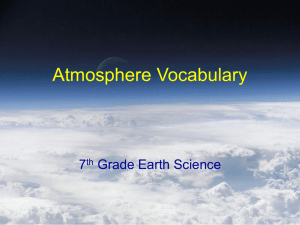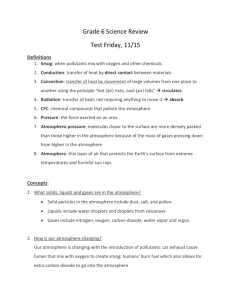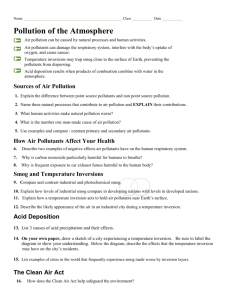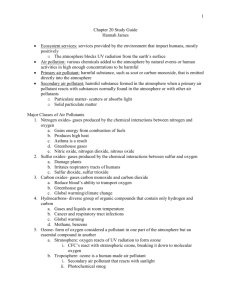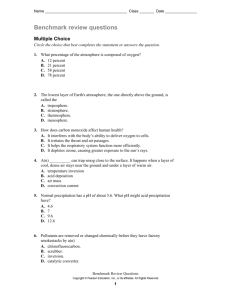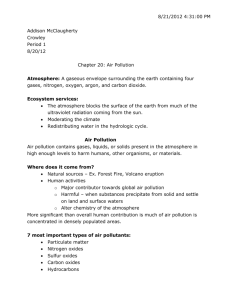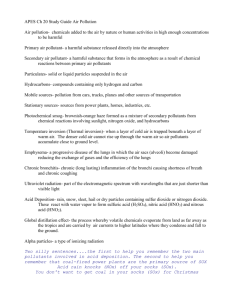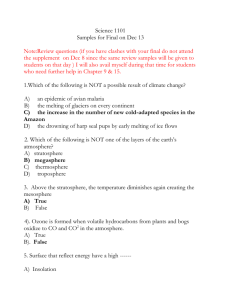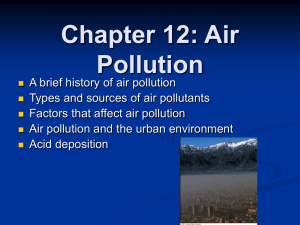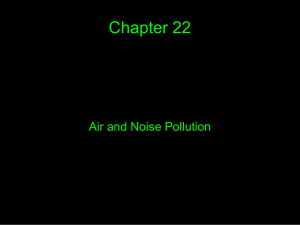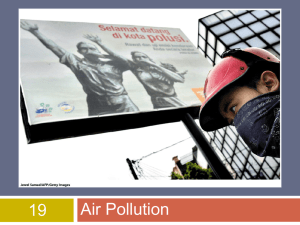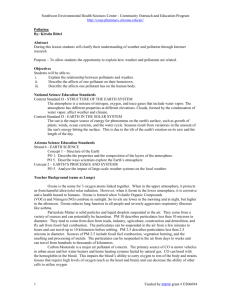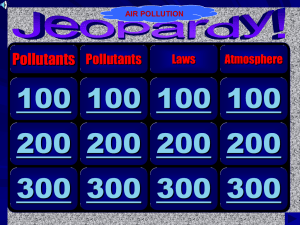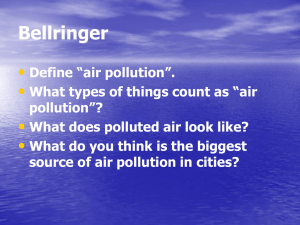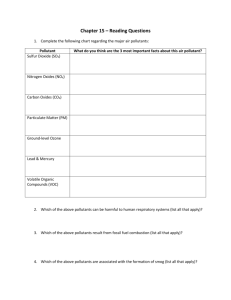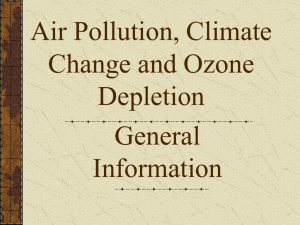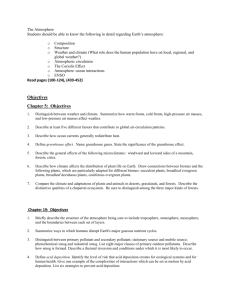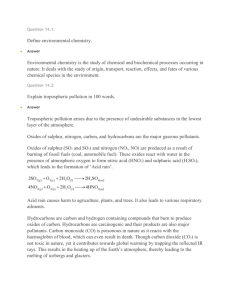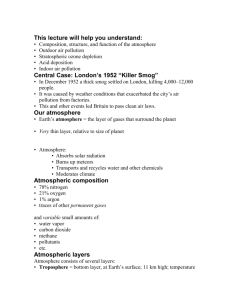STUDY GUIDE TO CHAPTER 22 - Fort Bend ISD / Homepage
advertisement
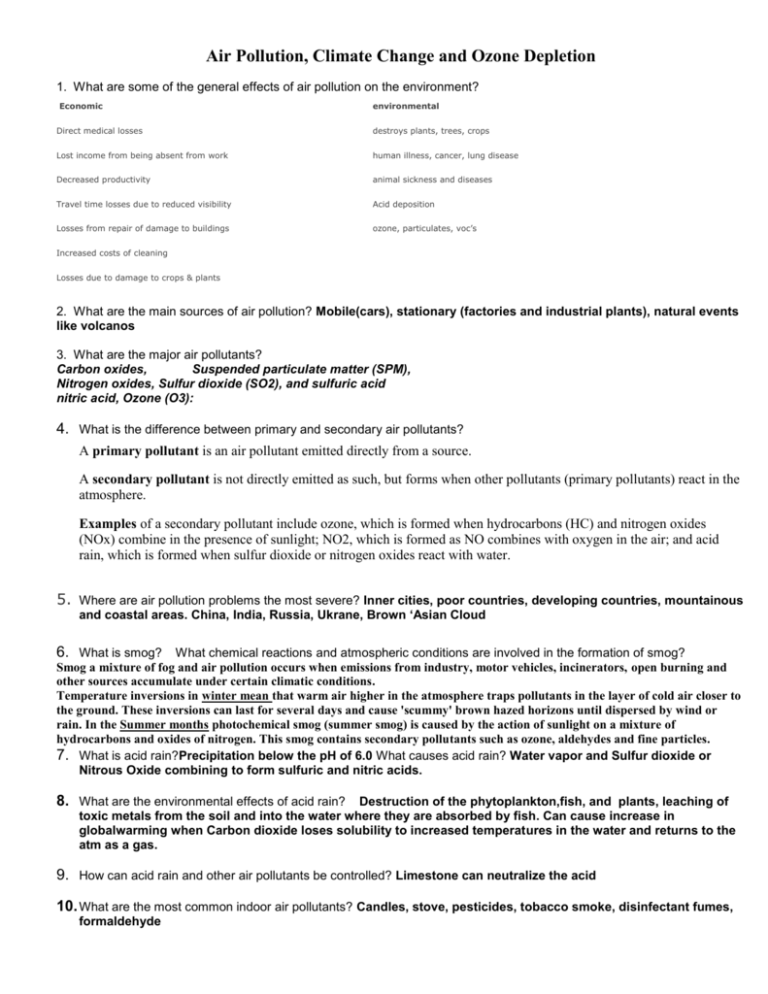
Air Pollution, Climate Change and Ozone Depletion 1. What are some of the general effects of air pollution on the environment? Economic environmental Direct medical losses destroys plants, trees, crops Lost income from being absent from work human illness, cancer, lung disease Decreased productivity animal sickness and diseases Travel time losses due to reduced visibility Acid deposition Losses from repair of damage to buildings ozone, particulates, voc’s Increased costs of cleaning Losses due to damage to crops & plants 2. What are the main sources of air pollution? Mobile(cars), stationary (factories and industrial plants), natural events like volcanos 3. What are the major air pollutants? Carbon oxides, Suspended particulate matter (SPM), Nitrogen oxides, Sulfur dioxide (SO2), and sulfuric acid nitric acid, Ozone (O3): 4. What is the difference between primary and secondary air pollutants? A primary pollutant is an air pollutant emitted directly from a source. A secondary pollutant is not directly emitted as such, but forms when other pollutants (primary pollutants) react in the atmosphere. Examples of a secondary pollutant include ozone, which is formed when hydrocarbons (HC) and nitrogen oxides (NOx) combine in the presence of sunlight; NO2, which is formed as NO combines with oxygen in the air; and acid rain, which is formed when sulfur dioxide or nitrogen oxides react with water. 5. Where are air pollution problems the most severe? Inner cities, poor countries, developing countries, mountainous and coastal areas. China, India, Russia, Ukrane, Brown ‘Asian Cloud 6. What is smog? What chemical reactions and atmospheric conditions are involved in the formation of smog? Smog a mixture of fog and air pollution occurs when emissions from industry, motor vehicles, incinerators, open burning and other sources accumulate under certain climatic conditions. Temperature inversions in winter mean that warm air higher in the atmosphere traps pollutants in the layer of cold air closer to the ground. These inversions can last for several days and cause 'scummy' brown hazed horizons until dispersed by wind or rain. In the Summer months photochemical smog (summer smog) is caused by the action of sunlight on a mixture of hydrocarbons and oxides of nitrogen. This smog contains secondary pollutants such as ozone, aldehydes and fine particles. 7. What is acid rain?Precipitation below the pH of 6.0 What causes acid rain? Water vapor and Sulfur dioxide or Nitrous Oxide combining to form sulfuric and nitric acids. 8. What are the environmental effects of acid rain? Destruction of the phytoplankton,fish, and plants, leaching of toxic metals from the soil and into the water where they are absorbed by fish. Can cause increase in globalwarming when Carbon dioxide loses solubility to increased temperatures in the water and returns to the atm as a gas. 9. How can acid rain and other air pollutants be controlled? Limestone can neutralize the acid 10. What are the most common indoor air pollutants? Candles, stove, pesticides, tobacco smoke, disinfectant fumes, formaldehyde Air Pollution, Climate Change and Ozone Depletion 11. Why are some people more strongly affected than others by indoor air pollutants? Allergies, Genetic makeup , Asthma, Lung Cancer and Emphysema, Heart Condition 12. What is radon gas and why is it an indoor pollution problem? Radon -222 found in rocks and soil. Comes in through the basement, cracks in foundation 12. What is the acceptable level of indoor radon as set by the EPA? 4ci/l 13. What are atmospheric conditions like in the troposphere and stratosphere? Draw an image of the atmosphere layers and give the distance above the earth and conditions for each on the back of this study guide. Troposphere 75% of mass of atmosphere 0 to 11 miles in altitude 78% nitrogen, 21% oxygen Location of Earth’s weather Temperature decreases with altitude until the next layer is reached, where there is a sudden rise in temperature Stratosphere 11 miles to 30 miles in altitude Calm Temperature increases with altitude Contains 1000x the ozone of the rest of the atmosphere; ozone forms in an equilibrium reaction when oxygen is converted to O3 by lightning and/or sunlight 99% of ultraviolet radiation (especially UV-B) is absorbed by the stratosphere Mesosphere 30 to 50 miles in altitude The temperature decreases with increasing altitude Thermosphere 50 to 75 miles in altitude Temperature increases with increasing altitude Very high temperatures 14. Describe each of these key properties of the atmosphere that influence weather and climate: air pressure: air temperature: humidity 15. What causes global air circulation and wind patterns? What is the prevailing wind in the continental US? Global air circulation is affected by the uneven heating of the earth’s surface by solar energy, seasonal changes in temperature and precipitation. 16. What is weather? What is climate? Weather is a local area’s short-term physical conditions such as temperature and precipitation. Climate is a region’s average weather conditions over a long time. Latitude and elevation help determine climate. 17. What are the types of climate by latitude? What is the significance of climate type for biogeography? 18. What is global warming? What factors affect the temperature at or near the Earth’s surface? 19. List the characteristics of: thunderstorms have high, cumulonimbus clouds that can reach 50,000 feet. An updraft of warm air causes cold air to rush downwards. This is why you feel a sudden cold breeze right before a thunderstorm. Lightening causes the ozone smell. tornadoes: Tornadoes are a powerful, rotating funnel of air associated with severe thunderstorms. Tornadoes form when a mass of cool, dry air collides with warm, humid air, producing a strong updraft of spinning air on the underside of a cloud. It is a tornado if the spinning air descends and touches the ground. hurricanes: Hurricanes are giant, rotating tropical storms with winds of at least 74 miles per hour, with some reaching 155 miles per hour. They form as strong winds pick up moisture over warm surface waters of the Air Pollution, Climate Change and Ozone Depletion tropical ocean and start to spin as a result of the rotation of the Earth. The spinning causes an upward spiral of massive clouds as air is pulled upward. 20. What causes the seasons? Tilt of the earths axis at 23.5 as it rotates around the sun. 21. Explain the Coriolis Effect. Global air circulation is affected by the uneven heating of the earth’s surface by solar energy, seasonal changes in temperature and precipitation 22. What causes wind? Wind is caused by the pressure gradient force. High pressure means more air, and low pressure means less air. The air moves from high to low, causing wind. 23. Why are they called the “Horse Latitudes”? Between about 30° to 35° north and 30° to 35° south of the equator lies the region known as the horse latitudes or the subtropical high. This region of subsiding dry air and high pressure results in weak winds. Tradition states that sailors gave the region of the subtropical high the name "horse latitudes" because ships relying on wind power stalled; fearful of running out of food and water, sailors threw their horses and cattle overboard to save on provisions. (It's a puzzle why sailors would not have eaten the animals instead of throwing them overboard.) The Oxford English Dictionary claims the origin of the term "uncertain." Define: Albedo The proportional reflectance of the Earth’s surface ConvectionThis causes rising air currents and leads to cloud formation. It takes heat from the lower atmosphere to the higher atmosphere where pressure is less, causing air to expand, which in turn cools the air. Conduction When Warm air holds more moisture than cold air. During conduction, heat & moisture from the ocean or land moves into the atmosphere. Scattering As the sun hits the earth, molecules are scattered into the air. This changes the direction of the heat coming in. Some are scattered back to space, but others are absorbed. Why the sky is blue. Radiation drives weather. Heat from the sun warms the earth, which radiates the heat back into the atmosphere.
